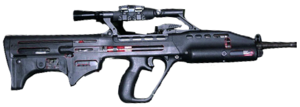SAR-21
| SAR 21 | |
|---|---|

The SAR 21 with the attached Round Corner Firing (RCF) module
|
|
| Type | Bullpup assault rifle |
| Place of origin | Singapore |
| Service history | |
| In service | 1999–present |
| Used by | See Users |
| Production history | |
| Designer | Tuck Wah Chee and Felix Tsai of Chartered Industries of Singapore (CIS, now ST Kinetics) |
| Designed | 1996 |
| Manufacturer | • CIS: 1999–2000 • ST Kinetics: 2000–present |
| Produced | 1999–present |
| Variants | See variants |
| Specifications | |
| Weight | • SAR 21: 3.82 kg (8.42 lb) • SAR 21 GL/M203: 5.3 kg (12 lb) • SAR 21 P-Rail: 3.6 kg (7.9 lb) • SAR 21 MMS: 3.5 kg (7.7 lb) • SAR 21 Light Weight Carbine 3 kg (6.6 lb) |
| Length | 805 mm (31.7 in) (SAR 21, SAR 21 40 GL/M203, SAR 21 P-Rail) 680 mm (26.8 in) (SAR 21 MMS) 640 mm (25.2 in) (SAR 21 Light Weight Carbine) |
| Barrel length | 508 mm (20.0 in) |
|
|
|
| Cartridge | 5.56×45mm NATO |
| Caliber | 5.56 mm (0.22 in) |
| Barrels | Single barrel 1:12" and 1:7" twist options |
| Action | Gas-operated, rotating bolt |
| Rate of fire | 450–650 rounds/min |
| Muzzle velocity | 970 m/s (3,182 ft/s) (M193) 945 m/s (3,100.4 ft/s) (SS109) |
| Effective firing range | 460 m (M193) 800 m (SS109) |
| Feed system | 30-round detachable box magazine; proprietary or STANAG magazines |
| Sights | 1.5x or 3x optical sight; back-up iron sights |
The SAR 21 ("Singapore Assault Rifle - 21st Century") is a bullpup assault rifle designed and manufactured in Singapore. First revealed and subsequently adopted by the Singapore Armed Forces (SAF) in 1999, it was designed and developed over a four-year period and was intended to replace the locally license-built M16S1 by the Singaporean Ministry of Defence (MINDEF), Singapore Army and the Chartered Industries of Singapore (CIS, now ST Kinetics). Many of its design features are directly intended to counter the weaknesses of the M16S1 as encountered operationally by some infantrymen.
The rifle is being sold for export use aside from domestic use. In the United States, it is being marketed by ST Kinetics via its American subsidiary, VT Systems.
Since the mid-80s, the SAF had an outstanding requirement to come up with a replacement for their M16S1 as most of these had been in use since 1973. In 1994, a proposal by SAF was submitted to the MINDEF for options to either procure newer weapons (thought was given to purchase the M16A2) or to develop its own indigenous rifle. On 19 November 2002, a patent was filed with the United States Patent and Trademark Office by Tuck Wah Chee and Felix Tsai with the patent number 6,481,144 B1.
MINDEF officials, after consultations with the SAF, decided against buying weapons off the shelf as it would require soldiers to adjust to the new weapon, choosing instead to develop a weapon, designed and made specifically for ease of use by the conscript soldiers of the SAF, who are mostly of slighter physiques. Coupled with the rising costs of maintaining the M16S1s in SAF's armory, this made it even more justifiable to develop a low-maintenance weapon.
The SAR 21 is made of a rugged, high impact polymer, most of the manufacturing is done utilising CNC machines, with ultrasonic welding for the steel-reinforced receiver halves and the gun barrel being cold hammer forged. It uses a modified Stoner operating system, boasting higher reliability and lower recoil. The translucent magazine allows precise assessment of current ammo load.
...
Wikipedia
